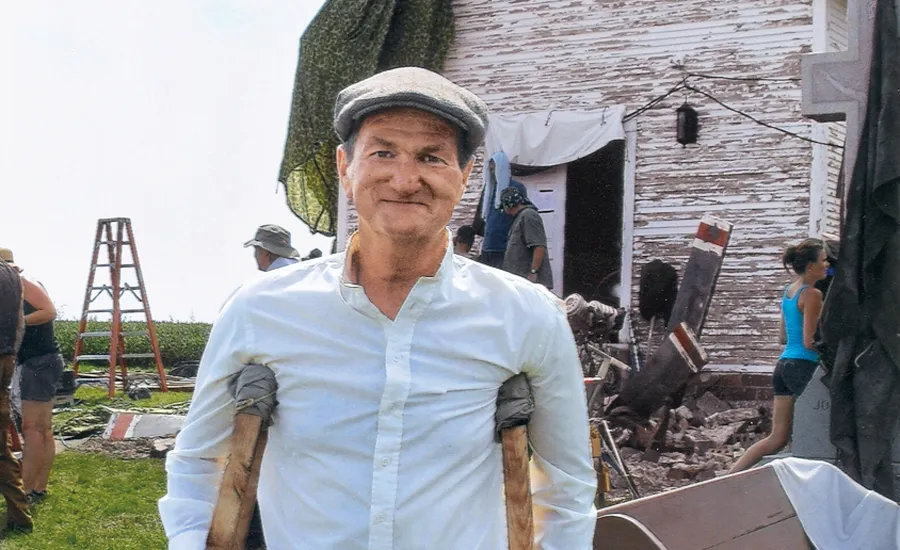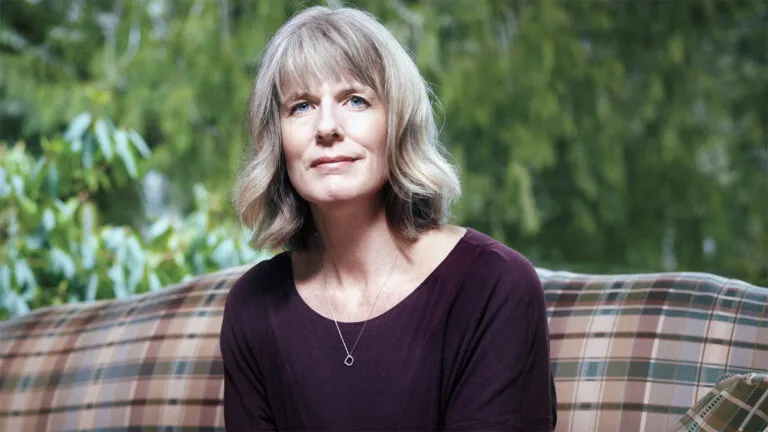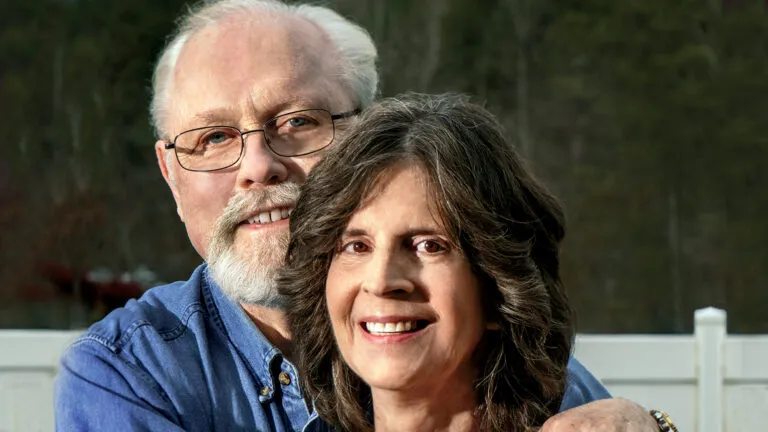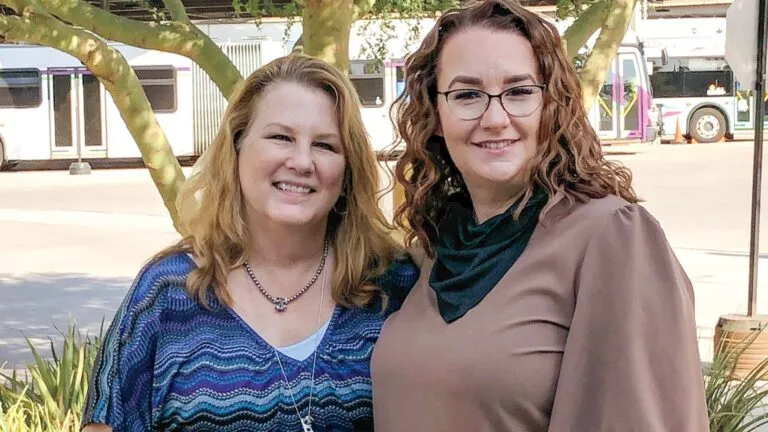Something about that old, abandoned church spoke to me. Whenever my Lab, Maggie, and I passed by on our walks out in the Minnesota farmland around my house, I’d find myself drawn to it.
The doors were always locked, and I’d never seen anyone go inside. I didn’t mind the rusty bell, the flaking paint, the crumbling concrete steps where I sometimes sat to pray. Maybe I felt a bit like the old church myself—worn down and way past my prime.
Five months earlier, I’d been diagnosed with Stage 4 head and neck cancer. I’d had 3 rounds of chemotherapy and more than 40 rounds of radiation. I’d just come home from what my doctors said would be my last treatment. Not because I was cured. Because my body couldn’t handle any more radiation.
My teeth had been removed to prevent a serious side effect of radiation. I had trouble swallowing and had to use a feeding tube—though I didn’t have much of an appetite. I’d dropped from 200 pounds to 145. The treatment had to be intensive to wipe out the cancer, I understood that. But so far the only thing that was wiped out was me.
Find out more about one of Guideposts.org’s sponsors: Cancer Treatment Centers of America
What was going to happen to me? How would I take care of myself if I got worse? My closest relative, my sister Brenda, lived an hour away. How long did I have left? My doctors couldn’t say. All I could do now was wait and see if the treatment controlled the disease.
Did I put myself through this torture for nothing? I wondered, tying my boots. I whistled for Maggie. Maybe some fresh air would do my spirit good.
I walked slowly past cornfields in harvest. Maggie darted ahead, then came back to make sure I was keeping up. The bell tower came into view. Maggie ran to the church and rolled in the grass. I collapsed on the steps.
I’d moved out to the country seven years earlier, after my divorce. I’d worked a number of different jobs by then—plumbing, roofing, insulating— but I wanted to do something different. Something I loved.
Dad, a jack-of-all-trades, had always inspired me with his do-it-yourself prowess. I built a workshop on my property and started my own furniture-restoration business. I’d spent many contented hours out there in my shop, with only my dog for company, making the old new.
Then I got sick. I’d wake up exhausted, even after a full night’s sleep. I had crushing headaches and was popping aspirin constantly just to function. Finally a specialist diagnosed cancer. Dad had died of lung cancer at 71. Was it my turn? I was only 55.
Maggie settled next to me on the steps. I ran my hands through her soft fur and closed my eyes. I wasn’t ready to go, but it felt like my body was giving out. Lord, I prayed, before I leave this earth I want to do something for you.
I opened my eyes. “Come on, girl,” I said, getting up from the steps. “Time to go home.”
Maggie didn’t race ahead of me as usual. I turned to see what she was up to. She stood still at the top of the steps, her head lifted, as if she was listening for something.
I was the one who heard it, though. A thought so clear that it had to come from the Lord.
Restore the church.
Why was God directing me, of all people, to do that? The church was in terrible condition. Fixing it up would take years—time I definitely didn’t have.
Still, I wasn’t about to ignore a call from God. I walked to the road. This time, Maggie came with me. I went to the nearest farmhouse and asked if they knew who had the keys to the church. A man named Don Rynda, I was told, who was part of the association in town that owned the building.
As soon as Maggie and I got home, I looked him up and called. “I’d like to restore the church from top to bottom,” I said. “I don’t expect anything in return. It would just be a way for me to serve the Lord.”
“You’ve got yourself a deal,” Don said, somewhat disbelievingly. He told me that St. John’s Chapel, founded by early Czech settlers in 1868, hadn’t had a congregation in nearly a century, though many people in town had ancestors buried in the cemetery.
I picked up the keys that day and went back to the church without my dog. I unlocked the door and pushed it open. The hinges creaked and groaned. I stepped inside.
Light filtered in through the dirty windows. Cobwebs covered the pews and the altar. The place looked like it had been frozen in time. Everything was still there. The paintings of Mary and Jesus on the walls. The candles in their holders. Even a dusty old Bible on the altar.
I walked in a little farther. Crrunch. My boots sank right through the floorboards. I was knee-deep in rotted wood. “Restore the church. Really, Lord?” I asked, glancing up. The roof was as bad as the floor. It was riddled with holes, a telltale sign of water damage.
Dad liked to say that if you’re going to do a job, you’d better do it right. I was too weak to give this job my all. And if I died partway through, I could leave the place in even worse shape than when I started. That wouldn’t be right. I had to go home and think about this some more.
The next morning I fed Maggie and sat at the kitchen table to read the morning paper. A glint caught my eye. The keys to St. John’s, lying on the counter, where I’d tossed them the night before.
I put down the paper. All right, Lord. I’m going. I threw a broom, a mop and bucket, and a few gallons of water in my pickup and drove to St. John’s. I went in with the broom, stepping over the hole in the floorboards. I swept the place from corner to corner.
Next I dumped a jug of water into the bucket and wet the end of the mop. I ran it back and forth over the floor, lifting off decades-old grime. I mopped until I used up all the water I’d brought.
Before I locked up, I took a look around the church. Simply cleaning the floors made the whole place seem different. Brighter. And I did that in just one day! I thought. What if I come back tomorrow?
The following morning I took on a more ambitious project: repainting the exterior. That wasn’t just a day’s work. It would take weeks. I was too scared to think that far into the future. I’d just have to take it one day at a time. Maybe that was all the Lord was asking of me.
READ MORE: SISTERS WITH SPIRIT
First, I had to remove the old paint. I set up my ladder, climbed up with scraper in hand and got to work. Each day I did as much as I had energy for. One day at a time, I told myself. It took three weeks just to get down to the bare wood. I must have scraped off 15 layers of paint.
Then I brushed on two coats of primer and three coats of fresh white paint. Maybe that sounds excessive, but if I was going to do a job, I’d do it right, like Dad said. I wanted this new paint job to last, long after I was gone.
Three months after I started (fortunately the weather cooperated), I finished repainting. That day I put my ladder back in my truck and walked around the building, admiring my work. Even in the weak winter sunlight, the church sparkled. I felt a tremendous sense of accomplishment.
I got to know that little church inside and out, from its leaky roof right down to its sagging floor. My to-do list grew. Retile the roof. Replace the floorboards. Repaint the interior. Remove the rust from the bell. Bring the pews home to refinish. I just took it one day at a time and stopped worrying about whether I would complete each project on my list.
Brenda didn’t stop worrying. “Are you taking care of yourself?” she asked. “Shouldn’t you be resting? Your health needs to be your first priority.”
I told her the truth: The more I worked, the better I felt. Every morning I woke up energized, eager to get to the church. My appetite came back. Sometimes Maggie came along, other days I went by myself. I sang and prayed while I worked, and never once felt alone.
One morning I drove up to the church with the pews in the bed of my truck. I’d taken them to my workshop to restore—replacing rotted wood, strengthening the joints with metal screws, sanding them and adding a fresh coat of paint.
I carried the pews back into the church and installed them one by one, surprised by how light they felt in my arms—I’d gotten stronger. With all the pews in place, the sanctuary looked so peaceful. The altar, simple but inviting with the old Bible spread open. I stepped up to it and read from the Book of Jeremiah: “For I will restore health to you, and I will heal your wounds, says the Lord.”
Was that why he’d called me to restore this church? So he could restore me to health? My body and my soul?
The next time I went in for a checkup, my doctors had good news: My test results showed my cancer was under control. It was too soon to tell if it was gone completely, but I couldn’t worry about that. I had more work to do at St. John’s. I’d already talked to Don about holding a holiday open house.
One day at a time. One week. One month. One year. Five years after I first stepped foot inside, the building is fully restored. So am I. My cancer is in remission. I’m eating real food again, and I’m back to a healthy weight.
I love welcoming visitors to the chapel in December, especially folks whose families once worshipped here. They’re amazed at the work I’ve done on the church. They’d be even more amazed if they knew how much work has been done on me.





